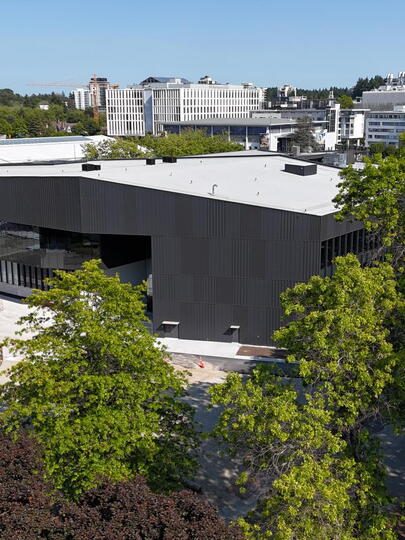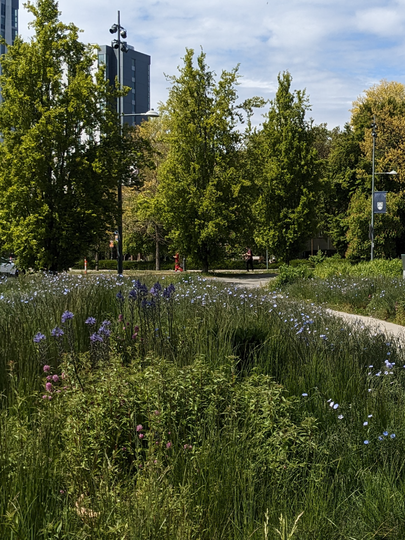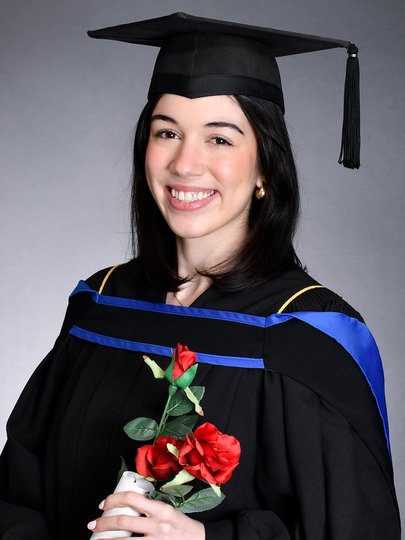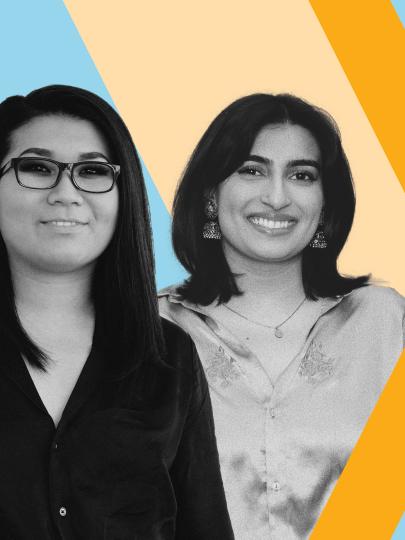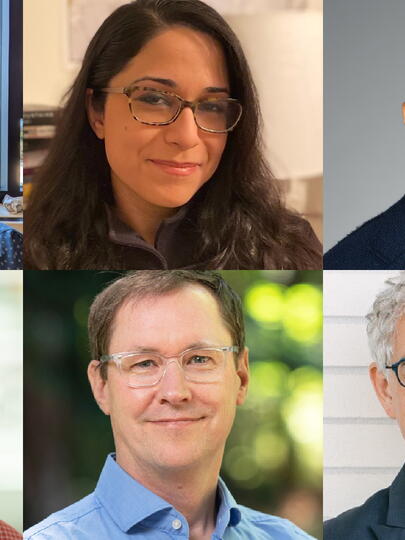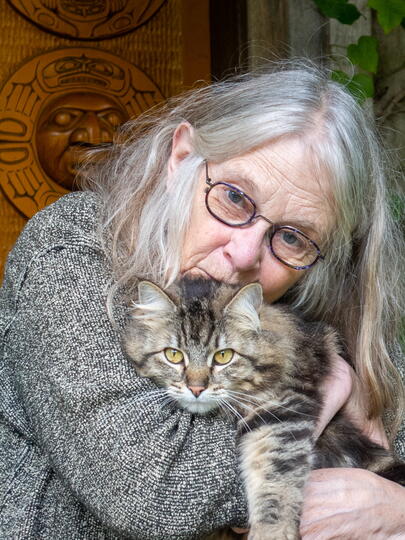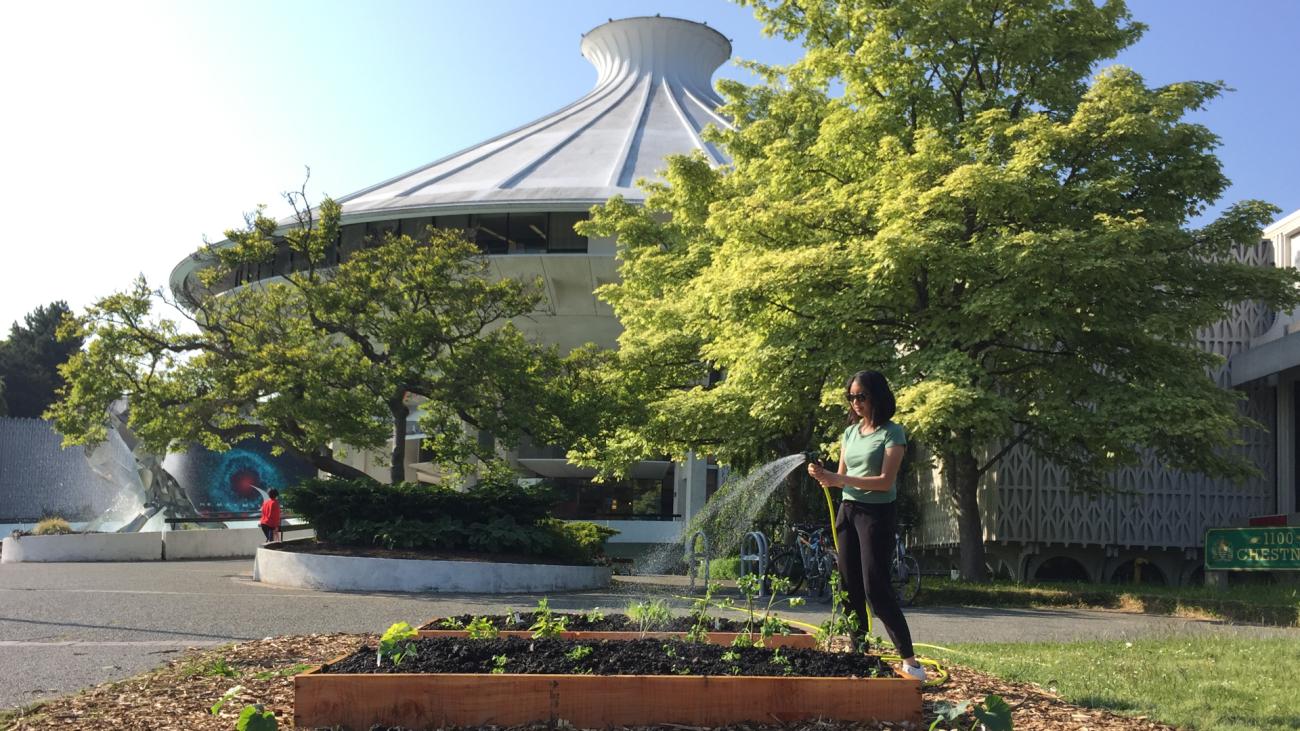Welcome to the centre without any walls
UBC’s new Centre for Asian Canadian Research and Engagement is centering the voices, experiences, and expertise of Asian Canadian communities.
One day, UBC’s new Centre for Asian Canadian Research and Engagement — otherwise known as ACRE — may have a space on campus to call home.
But, for now, the fact that its activities are not contained within four walls is, in my mind, one of its most poetic attributes.
Because although ACRE is not a centre in the physical sense, it is working to centre the voices, experiences, and expertise of Asian Canadian communities, both within the university and, crucially, beyond it.
Its deeply community-oriented approach to research, teaching, and engagement is grounded in longstanding relationships with cultural, civic, and non-profit organisations all across Metro Vancouver, and is inspiring students and alumni to work collaboratively to tackle the roots and impacts of racism and ensure that Asian Canadians of all backgrounds can thrive.
The centrality of community
If you ask ACRE’s academic co-leads Dr. JP Catungal and Dr. Henry Yu about what the new centre exists to do, you’ll learn that any definition about its purpose and activities revolves around the idea of community.
In general terms, “ACRE is a research centre at UBC, whose aim is to do scholarship, research, teaching, and community engagement work through the principle of ‘for our communities, by our communities,’” says Catungal, who also serves as Assistant Professor at the Institute for Gender, Race, Sexuality, and Social Justice.
This guiding principle reflects ACRE’s deep commitment to reversing what Yu, who is both the Principal of St. John’s College and an Associate Professor of History, refers to as “colonial knowledge production” — an approach to research that has treated communities as objects of study rather than as people with the capacity to define the questions and issues that are important to them.
Decolonizing this “extractive” approach to research is critical, particularly when it comes to working with marginalised communities, like the many diasporic Asian communities that have endured long histories of exclusion and racism in Canada.
Created in March 2022 as a legacy of UBC’s groundbreaking National Forum on Anti-Asian Racism, ACRE reflects the university’s commitment to countering anti-Asian racism and building a socially just future where Asian Canadians can thrive. To achieve this weighty goal means engaging with diverse communities in “ethical, reciprocal, and culturally appropriate ways.” These might sound like “fancy words,” Yu says, but they boil down to this important question: “What are the right ways to do things with communities?”
To start, building relationships “based on trust and mutually determined outcomes and goals” is key, says Yu. So too is presence — that is, “being on the ground, doing work, showing up in supporting what's important for our communities,” says Catungal. “It is an attempt,” he adds, “to move away from the kind of ivory tower approach to research.”
That’s why the absence of a physical edifice at UBC devoted to ACRE strikes me as both poetic — and practical:
“I would prefer that people saw our faces out in the community,” reflects Yu, rather than “make the community that we serve come to UBC in order to be helped. We need to take our capacity and resources — whether it’s our students, whether it’s our knowledge, whether it’s our research — and go out to meet communities where they are.”

Leading with students
If communities are at the heart of ACRE’s mission, then students are at the forefront of its work.
While ACRE is just over a year old, it builds on a longstanding history at UBC of engaging students in ethical, community-based work with Asian Canadian communities — a history that was, in fact, kick-started by some forward-thinking donors nearly twenty years ago.
In the fall of 2003, Yu, who is himself a UBC history alum (BA’89), returned as a newly hired professor to teach Asian migration history at his alma mater. (I was, in fact, one of the students fortunate enough to be in his very first course that fall.) Shortly after that, he was connected to Chinese Canadian donors who were keen on involving students in meaningful community projects. Their contributions led to the creation of the Chinese Canadian Teaching and Research Fund. Because acronyms (in)famously proliferate and take on a life of their own at UBC, one of Yu’s students noted that CCTR sounded too similar to CiTR, the campus radio station, and successfully pitched an alternative name: the Initiative for Student Teaching and Research in Chinese Canadian Studies, or INSTRCC.
That was the beginning of an innovative new program at UBC, spearheaded by donors, which since 2004 has been empowering students to work in ethical and responsible ways with diverse organisations supporting Asian Canadian communities.
"We need to take our capacity and resources — whether it’s our students, whether it’s our knowledge, whether it’s our research — and go out to meet communities where they are.”
Dr. henry yu, acre co-lead
Jenny Lu (BSc’18), a UBC grad who was one of Yu’s students and who now trains and mentors students on community-based work, tells me that her team has recently been thinking about INSTRCC as a kind of “talent agency,” one that sources “amazing talent” from students enrolled in a range of UBC courses. Students who participate in INSTRCC work placements are valued, and paid, for their contributions. Lu lists just a sampling of the expertise they bring to INSTRCC — “languages, communications, social media, design” — and adds that they apply what they learn from their ACAM classes in their positions as well.
Best known by its very pronounceable acronym, Asian Canadian and Asian Migration Studies, or ACAM, is a multidisciplinary minor program. Launched a decade after INSTRCC, it was created to honour the 76 Japanese Canadian students who were unjustly removed from the university after the start of WWII. The first ACAM courses were offered in September of 2014 and, like INSTRCC, reflect a community-centred approach to engaging students with Asian Canadian history and contemporary issues. The program’s creation involved extensive consultations with diverse Asian Canadian communities. Students, too, were central to its development, helping to shape the program in its infancy, and continuing to stay involved long after that. Innovative programs in their own right, ACAM and INSTRCC provide a solid foundation for ACRE’s development, one that remains driven by a longstanding priority at UBC: offering transformative learning experiences.
For Yu, ensuring that students have access to such experiences — ones that are meaningful for both the student and the organisation they’re working with — is crucial. It’s about bringing “the resources of the university in a way that is actually going to make an impact on our students and on communities and, ultimately, to lessen the impacts of anti-Asian racism and exclusion,” he says. “And so we are strategic about the project. We're strategic with our partners. We have community non-profit organisations as partners, but also a lot of these key institutions of power like museums.”
“Museums are very powerful,” he adds, “in telling our kids what's normal.”
For this reason, Yu has spent the past two decades cultivating strong relationships with cultural and heritage organisations all across Metro Vancouver. The partnerships he, Catungal, and other ACAM and INSTRCC faculty and staff have built from the ground up have led to fruitful collaborations that have provided students with meaningful experiences and form a strong basis for ACRE’s university-community collaborations moving forward.
From the award-winning A Seat at the Table exhibition at the Museum of Vancouver (MOV) and Chinese Canadian Museum (CCM), to the upcoming The Paper Trail exhibition, to open at the CCM on July 1, which marks the centenary of the 1923 Chinese Exclusion Act, UBC students and faculty have played and continue to play a key role in expanding Asian Canadian representation and storytelling in key cultural spaces. The list of projects that the INSTRCC team has completed with students over the past 20 years is impressive — and far too long to dive into here, but there are two that Yu highlights in particular.
The first is UBC’s collaboration with Burnaby Village Museum (BVM) over the past several years. In one of the projects, INSTRCC students worked closely with BVM staff to re-imagine the museum’s Chinese herbalist shop — an under-interpreted space that students noticed visitors weren’t really engaging with, and whose design may have had the unintended impact of “othering” traditional Chinese medicinal practices. One student, inspired by her childhood visits to such shops, suggested incorporating a smelling station to pique visitors’ curiosity about each herb and spark conversations about how food and medicine are one and the same in Chinese culture. The resulting space was not only more interactive and engaging, but it also helped visitors better understand an approach to medicine that might otherwise have been seen as “strange” or “exotic.”
Yu also highlights an upcoming exhibit at the Gulf of Georgia Cannery — Fish Tales — set to open later this month, which dives into the stories of people’s diverse experiences with seafood. INSTRCC students, he tells me, pitched the idea to focus not on the history of the cannery or on fish production, but on the stories of ordinary Richmond citizens and the ways they have consumed fish and seafood.
When this exhibit opens, the hope is that more Asian Canadian community members will be able to see themselves and their stories in spaces that have historically left them out. This matters, says Yu, because “one of the things that is so crucial about the exclusions of the past is that in places like museums and cultural institutions, you don't see yourself, you don’t see your own life. It's not meaningful to you because it's a story about someone else — and you were never part of that story.”
Yu reiterates that this project was “led by students” — an approach that he recognizes may sound unconventional, but it’s about “getting away from the idea,” he says, “that the most important person at a research university is the research professor.” Ultimately, he sees ACRE as continuing to empower students to lead in the same way that INSTRCC has done to date — providing students with the mentorship, space, and trust to collaborate with community partners, identify needs, and find creative and culturally appropriate solutions to meet those needs.
This kind of empowerment supports students not only during their time at UBC, but has ripple effects long after they have graduated.
The multiplier effect
In the fall of 2014, Christina Lee (BA’18), then a second-year UBC student, was scrambling to find a history class that would fit her schedule. Lee came across Yu’s fourth-year ACAM course on Asian migrations in the Americas and sent him an email to see if he thought she could handle it. Yu encouraged her to show up for a class, and if she liked it and felt she could manage her time, she was welcome to stay.
Lee had not yet heard of the newly launched ACAM program, but getting into the course ended up being a serendipitous — and career-defining — turn of events.
“I loved it,” she says. The course’s “community-centred lens really changed the way that I could imagine my work to be.”
Lee went on to pursue an ACAM minor, and noticed a pattern in all of its courses: the requirement that term projects be something that could be broadly shared with one’s community. It made her think about the knowledge generated in traditional coursework, which usually takes the form of a paper read by a single prof or TA. ACAM’s approach really “turned that on its head,” sparking Lee to ask, “What is our accountability to the community when we are doing research? What are we giving back to them? And what’s useful to them?”
These are questions that Lee regularly ponders in her policy and advocacy role at the hua foundation, where she has been working since graduating from UBC. The foundation, based in Vancouver’s Chinatown, is a non-profit that seeks to empower Asian diasporic youth to build a more equitable and just future. Lee points to an early project she worked on for hua, which kicked off during her last semester at UBC, where she was able to do the kind of community-centred work that ACAM had introduced her to.
Tasked with speaking with business owners in Vancouver’s Chinatown to understand the issues and challenges they were facing, Lee applied the principles of ethical, community-based research to the project. Recognizing that English was not the first or operating language for many business owners — as well as the inherent vulnerability and challenge of answering questions about why one’s business might be struggling — Lee knew that it was important that each interviewee had the opportunity to express themselves as fully as possible. So she hired Research Assistants (RAs) to conduct the interviews in Cantonese and Mandarin.
“I think that we got better answers because of that,” reflects Lee, “because we centred their trust and their vulnerability and the relationship as part of the process of building the research for that project.”
Her sensitivity to community needs didn’t end at the level of language. Because many of the interviewees were restaurant owners who worked 70 hours a week, it was not practical to ask them to set aside time for a sit-down interview. Instead, the RAs conducted interviews on foot, asking questions during moments when the owner wasn’t busy serving a customer or managing the front counter.
The extra effort by Lee and her team of RAs led to quality data and stories, published in the hua foundation’s resulting Vancouver Chinatown Social Cohesion Report. Lee tells me that this project really shaped the research that she has since done, reminding her to continually ask: “How do we meet people where they're at so that they feel comfortable sharing? How do we use language as a facilitator of trust?”
Since starting at the hua foundation in 2018, Lee has continued to maintain her relationship with the ACAM program and has partnered with Catungal on a number of projects, most notably the C19 Response Coalition and the Language Access Project.
When COVID-19 hit, hua was concerned about the communities that might get left behind due to the lack of public health information in languages other than English and French. To address this gap, they convened the C19 Response Coalition, made up of community organisers and partners representing the Chinese-, Tagalog-, and Vietnamese-speaking communities, and together they launched c19help.ca. The site offers official and up-to-date information about COVID-19 in all three languages (including both simplified and traditional Chinese), and helped to counter the disinformation that was so rampant at the start of the pandemic. As a member of the Filipino community, Catungal was involved in the coalition’s advisory committee, contributing to the Tagalog translation work, and also partnered with hua in successfully applying for a Partnership Recognition and Exploration Fund from UBC Community Engagement for this project.
"How do we meet people where they're at so that they feel comfortable sharing? How do we use language as a facilitator of trust?”
- christina lee (Ba'18), hua foundation
The work that the coalition did to ensure that communities that don’t speak majority languages get the critical information they need to stay healthy was an eye-opening experience, and Lee, alongside other coalition members, began asking, “What can we learn from this? And what can we share?” One of the “meta lessons” of this experience, says Catungal, was realising that “large institutions like governments and public health folks, and even universities and colleges, are not equipped to actually understand language access as a social justice issue.”
Further thoughts and discussions led to the Language Access Project (LAP), for which Lee is the Project Lead. The purpose of LAP is to offer “communications professionals a set of best practices for language accessibility,” says Catungal, who serves as an advisor on the project, representing UBC ACAM. By language accessibility, Catungal means ensuring that information (such as public health orders relating to COVID-19) is translated in ways that are culturally appropriate and that will resonate for its target audiences.
The team behind LAP recently published its “Language in Practice” toolkit for communicators, which, Lee explains, is intended, just like c19help.ca, to help ease the burden that falls on “translator kids” — individuals who have to convey information and act on behalf of family members to keep them up to date on vaccinations and other public health orders. Lee’s passion for policy work comes through in her thoughtful questioning of how she can help build “systems and structures” so that it takes “free labour off of the family members and other community members” who so often have to fill gaps in care. She’s one of the many ACAM graduates who, as Yu puts it, is contributing to a “multiplier effect” in the community: students who were changed by their experience at UBC who then go out to create positive — and outsized — change in the world around them.
But it’s not only ACAM graduates like Lee who have a ripple effect in their communities. Even those who don’t enrol in the minor program but who take just a handful of classes find the inspiration they’re seeking to benefit the communities around them.
UBC alum Alyssa Sy de Jesus (MA'21) is one such example.

Academia re-imagined
After earning her undergraduate degree from Simon Fraser University and working in the heritage sector for a few years, Alyssa Sy de Jesus decided to take an ACAM course in the fall of 2015 as an unclassified student. “I missed school,” she tells me, and “I wanted to see if there was a community that was looking to engage between academia and community in the way I was thinking.”
The first course she took was with Dr. Chris Lee, ACAM’s Director, and it provided her with just what she was looking for — “space to think through Asian Canadian identity” — as well as a community of students and faculty who “were also in the diaspora” and with whom she “didn’t feel like the odd one out.” Her experience led her to take two more courses in ACAM and also helped her decide to apply to graduate school at UBC. “I guess I’m a big fan,” she says with a laugh.
Since her first course in 2015, Sy de Jesus has felt “welcomed by the ACAM community” and continues to work with its instructors and students today. When, for example, she got hired as a Program Manager by the Museum of Vancouver in 2022, she got in touch with Yu and Denise Fong (BA’03, MA’08), co-curators of A Seat at the Table, keen to collaborate on an event at MOV that would help “activate the ideas” around the exhibit. The result was an event on food, film, and activism, which also featured a film made by one of Yu’s INSTRCC students.
Sy de Jesus shares that it was “such a joy” to work with the UBC team and to “speak the same language of moving between academia and community.” Listening to her speak about her passion for meaningful community collaborations, I am not surprised to hear that Sy de Jesus loves being what she delightfully calls a “matchmaker” — “finding the Venn diagrams, the connections between places and people and their work.” In addition to her role at the MOV, she’s currently a community consultant on a three-year project with Heritage Vancouver, UBC Public Humanities Hub, and ACAM, a set of partners that she convened to help capture oral histories of the Filipino-Canadian community.
The idea for the project emerged during her time as a volunteer with Heritage Vancouver. She had heard about a youth-run organisation called Sliced Mango Collective (SMC) that was helping to organise the Filipino Canadian community in Joyce-Collingwood, who were “under threat from a proposed development that was in no way sensitive to the economic and cultural realities of the neighbourhood.”
The rezoning application, which would have allowed the proposal to move ahead, has since been stalled, thanks to community activism. Inspired by SMC’s work, Sy de Jesus organised a panel that included one of the collective’s members as a speaker. However, she, along with fellow collaborator Sydney Lines, a UBC PhD candidate, were both keen to do more than a one-off event. “How do we continue the relationship,” she asks, “in a way that benefits community members?” So they decided to apply for a Heritage BC grant at the end of 2021 to fund a project aimed at collecting the oral histories of the local Filipino Canadian community and creating an online exhibition to share them. The Kuwentong Pamamahay Project — which means “stories of homemaking in the Filipino Canadian community” — was granted funding and is set to launch some time in 2025, and will showcase the intangible cultural heritage of neighbourhoods like Joyce-Collingwood, with its rich concentration of Filipino restaurants and businesses.
"[ACAM] is a part of UBC that values working with community and it’s not going to be extractive about it. It’s about being responsible and reciprocal to Asian Canadian communities.”
- alyssa sy de jesus (MA'21), museum of vancouver
Sy de Jesus shares that she had wanted to bring ACAM into the project as a collaborator because of its community-centred approach. “This is a part of UBC that values working with community,” she says, “and it’s not going to be extractive about it. It’s about being responsible and reciprocal to Asian Canadian communities.” Catungal, as ACAM’s lead on the project, will be training Filipino community members to conduct the oral history interviews, so it’s “not someone from the university...or from a cultural institution interviewing community,” Sy de Jesus says. “It’s community interviewing community.” The interviewers also get to choose who they speak with, which is another way that traditional methods of research (in which an external “expert” both selects interviewees and conducts the interviews) is being turned on its head. This community-oriented approach long championed by UBC’s INSTRCC and ACAM teams is being applied by Sy de Jesus — and many other grads — to serve their communities.
When I ask Sy de Jesus what she hopes ACRE will become as it moves into its second year of work, she tells me that she hopes it will help “change the conversation around what someone’s time at UBC, what someone’s time in academia, can be about — that it is about serving your communities.”
Thinking about her experiences in ACAM and what it’s been like working with Catungal and Yu on past and current projects, she shares that they both embody how “academia becomes a means through which to serve your communities.” No one who spends even just a short time speaking with ACRE’s co-leads and staff, and with UBC alumni like Sy de Jesus and Lee, can fail to notice the passion they bring to their work with, for, and by Asian Canadian communities. It’s a passion that long precedes ACRE’s launch in 2022, and one that I expect will supercharge this next exciting phase of Asian Canadian research, teaching, and community engagement at UBC.
“Growing in our capacity means growing in our impact,” says UBC ACRE co-lead Dr. Henry Yu.
To help ACRE grow in its capacity so that UBC faculty, staff, students, and alumni can continue to pursue socially just futures with and for Asian Canadian communities, visit the Give UBC website.
To be the first to receive news about ACRE, join its mailing list.


